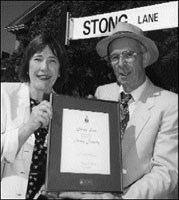University dedicates Stong Lane in honour of pioneering Stong family

HERITAGE LANE: President Lorna Marsden joins Vernon Stong, great grandson of the pioneer couple who built the Stong House, at the dedication of Stong Lane.
The contribution and pioneering spirit of the Stong family to the development of the land on which York's main campus is located was honoured at a special ceremony on Thursday, July 9 when the University dedicated, as "Stong Lane," the laneway leading to the historic Jacob and Sarah Stong House near the intersection of Steeles Ave. W. and Keele St.
A permanent street sign, specially prepared for the occasion, now marks Stong Lane.
Members of the extended Stong family in attendance at the event included Vernon Stong, Joe Stong, Robert Stong, Mary Burton, Jean Constable, Mr. and Mrs. Herbert Constable, Mr. and Mrs. Elmer Stong and Greta Thompson.
Following greetings on behalf of the University by President Lorna Marsden, Vernon Stong, the great grandson of the man and woman who built the house circa 1855, dedicated Stong Lane.
"It was in this house with the barn and the gardens that I enjoyed my childhood years until 1952," he reminisced. "I came into this world in this house. I have vivid recollections of walking, playing and shovelling the snow in this lane. I stand on this piece of land with much pride and admiration for the Stong family."
The Jacob and Sarah Stong House, currently is used by the Faculty of Fine Arts as a studio facility.
The Stong (originally spelled "Stang") family were descendants of the Palatine Germans, who migrated from Pennsylvania and settled in York County after the American Revolution, according to a recently updated heritage structure report. Several generations of the Stong family occupied the lands, beginning with Daniel Stong (1791-1868) and Elizabeth Fisher Stong (1798-1885) as the first settlers in 1816.
Daniel Stong was born in Pennsylvania and came to Canada with his parents in 1800. He married Elizabeth Fisher of Vaughan Township in 1816. Their two restored log houses still stand as reminders of early pioneer life in Upper Canada, as part of Black Creek Pioneer Village.
"Through painstaking hard work and intensive farming over many years, Daniel and Elizabeth had acquired over one-thousand acres of what was considered to be the most fertile soil in York and Vaughan townships," the heritage report states.
Jacob Stong, born in 1821, was the third child and eldest son of Daniel and Elizabeth. At the time of the William Lyon Mackenzie Rebellion, Jacob, then 16, and Daniel threw in their lot with the Reformers. Daniel was captured by the Loyalists and imprisoned by the government.
In 1841, Jacob married Sarah Snider, the daughter of Samuel Snider of York Township, and settled on land that is now the north-west portion of Keele St. and Finch Ave. Subsequently, he purchased from his father the 80-acre parcel now occupied by the University and built the present house.
Known as a great judge of livestock at county fairs and an active participant in barn raisings throughout the area, Jacob Stong was appointed a Justice of the Peace in 1874. He lived to age 78 when he was killed, along with his eldest daughter, at Downsview crossing on the Northern Division of the Grand Trunk Railway.



